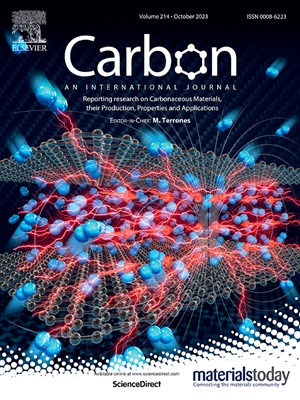The quantum mechanical origin of the supercapacitance phenomenon in reduced graphene oxide structures
IF 10.5
2区 材料科学
Q1 CHEMISTRY, PHYSICAL
引用次数: 0
Abstract
We investigated supercapacitance phenomena observed in reduced graphene oxide structures from a quantum mechanical rate viewpoint. The supercapacitance phenomenon in carbonaceous materials has been majorly attributed to electrostatic capacitance contributions, in which the magnitude of this capacitance is correlated with the amount of surface area available to be charged under the presence of electric potential perturbations. Nonetheless, the quantum rate theory predicts a superposition between electrostatic and chemical (also called quantum) capacitance energetic levels. The superposition of these capacitive states implies that the electric potential perturbation not only drives the separation of charges in space (thus correlating with the geometry of the capacitor and consequently with the surface area) but also governs the occupancy of the electric-field screened electronic structure of reduced graphene oxide embedded in the electrolyte environment. This leads to an energy degeneracy between electrostatic and quantum capacitive energy states, as confirmed in this work for reduced graphene oxide carbonaceous structures. Accordingly, the analysis proves that the charge dynamics associated with the resistance for charging the pseudo-capacitive states of reduced graphene oxide structure follows a quantum resistance limit k within a charging frequency of that obeys quantum electrodynamics principles, in agreement with the premises of the quantum rate theory. Two energy levels associated with the occupancy of the electronic states upon the reduction of graphene oxide were identified.
还原氧化石墨烯结构中超级电容现象的量子力学起源
本文章由计算机程序翻译,如有差异,请以英文原文为准。
求助全文
约1分钟内获得全文
求助全文
来源期刊

Carbon
工程技术-材料科学:综合
CiteScore
20.80
自引率
7.30%
发文量
0
审稿时长
23 days
期刊介绍:
The journal Carbon is an international multidisciplinary forum for communicating scientific advances in the field of carbon materials. It reports new findings related to the formation, structure, properties, behaviors, and technological applications of carbons. Carbons are a broad class of ordered or disordered solid phases composed primarily of elemental carbon, including but not limited to carbon black, carbon fibers and filaments, carbon nanotubes, diamond and diamond-like carbon, fullerenes, glassy carbon, graphite, graphene, graphene-oxide, porous carbons, pyrolytic carbon, and other sp2 and non-sp2 hybridized carbon systems. Carbon is the companion title to the open access journal Carbon Trends. Relevant application areas for carbon materials include biology and medicine, catalysis, electronic, optoelectronic, spintronic, high-frequency, and photonic devices, energy storage and conversion systems, environmental applications and water treatment, smart materials and systems, and structural and thermal applications.
 求助内容:
求助内容: 应助结果提醒方式:
应助结果提醒方式:


